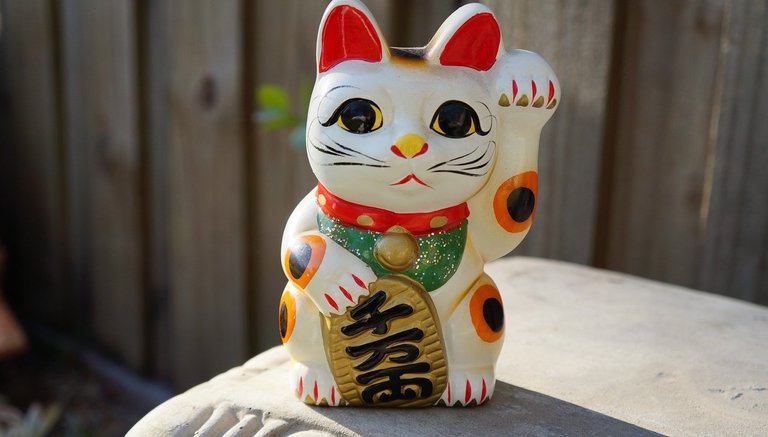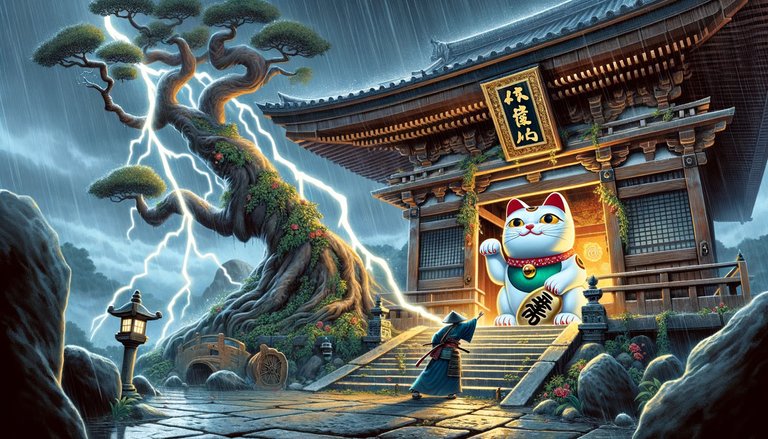Maneki Neko - The Lucky Beckoning Cat
I was translating a haiku that I may or may not post here and it had a reference to maneki neko, which is probably better known in the West as Lucky Cat or Beckoning Cat, so I thought I might post about it and give some general info.
You all know what I'm talking about. Here is a typical one:

Image by Carla Burke from Pixabay
There might be some slight variation, but usually the figurines look pretty close. It is a Japanese Bobtail cat beckoning with the traditional Japanese beckoning gesture, which is underhand (usually only using the fingers) and not overhand like it is in the West.
(As an aside: Basically the Japanese gesture has your hand somewhat parallel to the ground, palm pointed down, and wagging the fingers to and fro. To Westerners, it looks like they are being shooed off or told to go away, but it means the opposite, that they are being told "c'mere". The overhand gesture common in the West can be considered rude to some Japanese. See here.)
Basically the idea is the cat is bringing us good luck. Some of the more common variations are using the right paw for money and the left paw for attracting business, and different colors: white for general good luck, red for good health, black to ward off evil, yellow/gold for wealth, and pink for romance.

Image by Emanuel Golabiewski from Pixabay
Besides the raised hand, the cat is usually wearing or holding a koban, a golden coin in use at the time. I previously wrote about the koban here. Written on the koban is usually "10 million ryō" (千万両, sen man ryō), ryō being the highest unit of currency in the Edo era. 1 koban was worth 1 ryō (well, it varied, but at least at the beginning of the Edo era, it was worth that), so that's 10 million gold coins! Bet my buddies in #silvergoldstackers are drooling at the possibility. I am!
You sometimes see other things written on the coin, like simply "money" (お金, okane), something like "great luck" (大吉, daikichi), "luck" (福, fuku), or... oh, any number of other things. But that 10 million ryō (千万両) is the most common.

There are a number of folklore stories claiming to be the origin of maneki neko. The most famous of these involves Ii Naotaka who, on his way home from falconry, noticed a cat beckoning him from the gate of a temple. Shortly after stopping and entering the temple out of curiosity, a huge and violent thunderstorm hit. Due to this, the temple soon became the family temple of the Ii clan and the temple created maneki neko to honor this great luck for their temple.
Another variation of this story has Naotaka stopping at the temple to rest and sitting under a tree to read. Noticing a cat beckoning him, he away from the tree towards it. Moments later the tree was struck by lightning.

ChatGPT's version of this scene. Since it is a folktale, I suppose a giant bobcat is as realistic as any of the rest of the story.
There are several other competing folktales. A more realistic one goes on to tell us that a poor shop keeper took in a stray cat despite barely having enough to feed his family. In gratitude for the kindness of the shopkeeper, the cat would sit in front of the store beckoning customers. Drawn by the strange sight of a cat beckoning people, customers soon flocked to the shop and the shopkeeper became very rich. Ever after, a beckoning cat became a symbol of good luck.
A more grisly tale involves a oiran (for simplicity's sake, think of an oiran as a kind of geisha who was, at the lower levels, a sex worker) who always carried a cat with her. Depending on the version of this story either she got it in her head that the cat was bewitching her and beheaded it or her employer got that idea and did the beheading. Either way, when she was later using the toilet, the cat head came to life and attacked a snake that was about to bite her, saving her life. In honor of this, the figurine was made.
Whatever the true origin is, they first started appearing around the Genroku Era (1688–1704) in Asakusa in Edo (now Tokyo). The area was becoming very popular at this time for pottery due to good clay suitable for pottery having been discovered.
And flash forward to now when they are not only one of the most popular good luck charms in Japan, but also pretty popular in the rest of Asia as well. In fact, they are so common in Chinese communities, that they are frequently mistaken for being Chinese instead of Japanese.
Today at that temple mentioned in the first folktale (Gotoku-ji) you can find hundreds maneki neko figures. There are some festivals that feature the figure where people dress up as the cat. Okayama even has a museum dedicated to the beckoning cat, as does Cincinnati in America.
I think we can safely say it's a pretty popular good luck charm. Next time you see one at the store, why not pick it up? Who knows, it might work and bring you good luck!

From Gotoku-ji — via Wikipedia
In the spirit of maneki neko, I'll be doing a post for my buddies in #silvergoldstackers with some cat coins sometime within the next few weeks. But here's a preview I found:

Now that would be a nice silver piece to have! A good luck cat, and silver!
❦
 |
David LaSpina is an American photographer and translator lost in Japan, trying to capture the beauty of this country one photo at a time and searching for the perfect haiku. He blogs here and at laspina.org. Write him on Twitter or Mastodon. |
You received an upvote of 90% from Precious the Silver Mermaid!
Thank you for contributing more great content to the #SilverGoldStackers tag.
You have created a Precious Gem!
I had no clue that's why it's so popular! Those are some great stories, minus the one about the cat being beheaded. 😬
!BBH
!PIMP
You must be killin' it out here!
@bulliontools just slapped you with 1.000 PIMP, @dbooster.
You earned 1.000 PIMP for the strong hand.
They're getting a workout and slapped 1/1 possible people today.
Read about some PIMP Shit or Look for the PIMP District
@dbooster! Your Content Is Awesome so I just sent 1 $BBH (Bitcoin Backed Hive) to your account on behalf of @bulliontools. (3/20)
That is a pretty crazy one. I wonder how forklore that bizarre even gets started.
Yeah, that one is far out there. Maybe there was a contest for who could come up with the most bizarre version of the story. !LOL !BBH
@dbooster! Your Content Is Awesome so I just sent 1 $BBH (Bitcoin Backed Hive) to your account on behalf of @bulliontools. (6/20)
lolztoken.com
That was a very fuelish thing to do.
Credit: reddit
@dbooster, I sent you an $LOLZ on behalf of bulliontools
(1/4)
ENTER @WIN.HIVE'S DAILY DRAW AND WIN HIVE!
🤣 was about to say a silver one would be cool and what do you know !BBH !PIMP
You must be killin' it out here!
@bitcoinman just slapped you with 10.000 PIMP, @dbooster.
You earned 10.000 PIMP for the strong hand.
They're getting a workout and slapped 3/3 possible people today.
Read about some PIMP Shit or Look for the PIMP District
@dbooster! Your Content Is Awesome so I just sent 1 $BBH (Bitcoin Backed Hive) to your account on behalf of @bitcoinman. (3/50)
I read your mind 😃
Very interesting. I actually think the only time I have really seen this is when I am at the casino. There are any number of machines that incorporate this theme. Learning the history behind it is pretty cool though, I never would have guessed!
I really had no idea either until I visited a shrine that sold them once a few years ago and the guy there told us all about them. A strange history for what has become such a popular figure.
Very interesting!
Very interesting, I had never heard of it. I like the silver version best myself! Great post!
The silver version is always best! Well...maybe a gold version...
A gold one would be awesome!
Hello dbooster!
It's nice to let you know that your article won 🥇 place.
Your post is among the best articles voted 7 days ago by the @hive-lu | King Lucoin Curator by keithtaylor
You and your curator receive 0.0171 Lu (Lucoin) investment token and a 9.82% share of the reward from Daily Report 265. Additionally, you can also receive a unique LUGOLD token for taking 1st place. All you need to do is reblog this report of the day with your winnings.
Buy Lu on the Hive-Engine exchange | World of Lu created by @szejq
STOPor to resume write a wordSTART